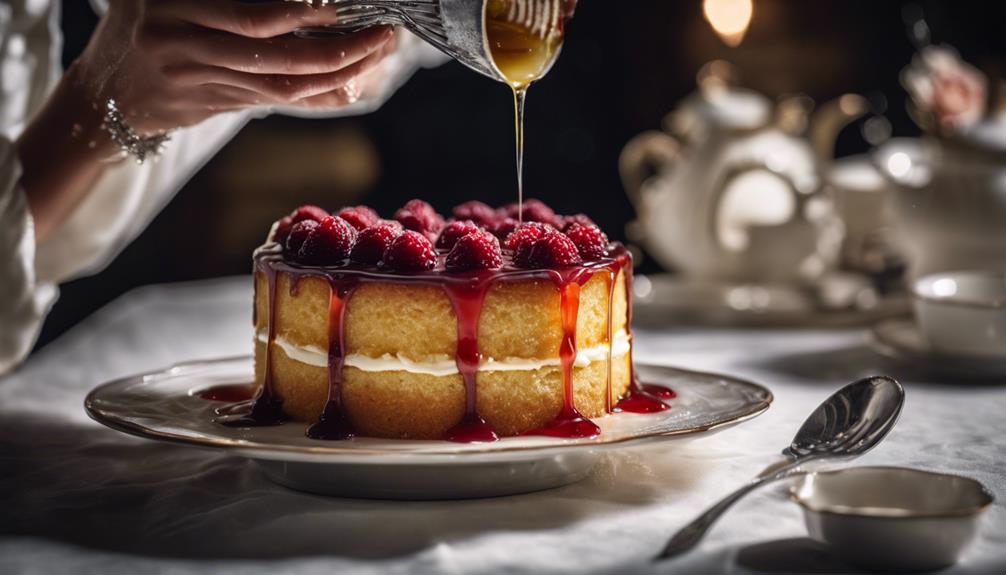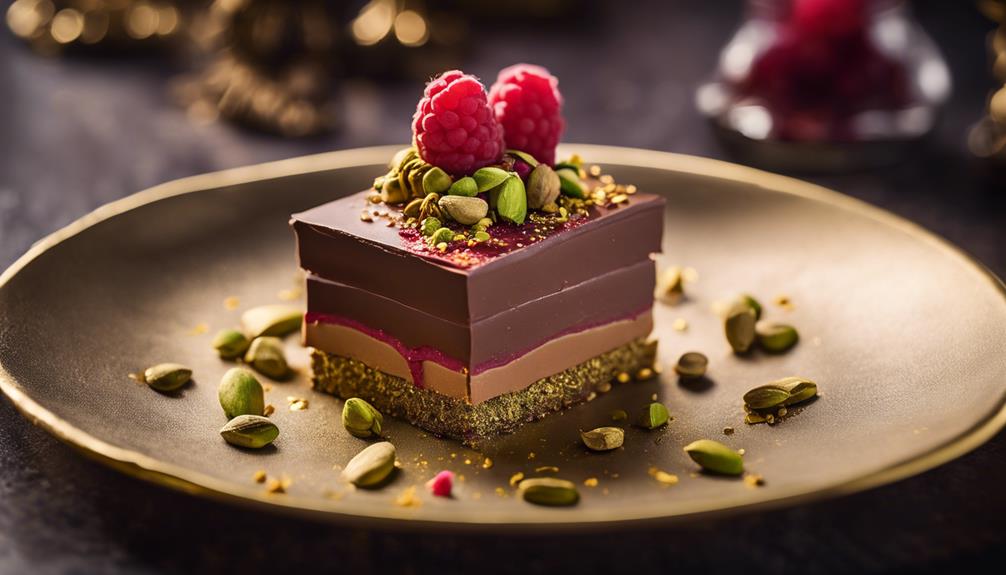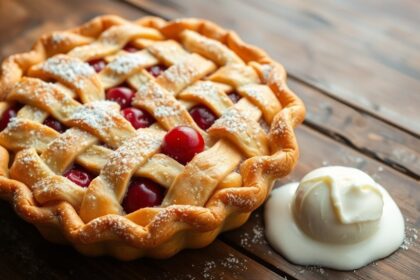Crafting the perfect opera dessert demands a blend of flavors and precise techniques to elevate your culinary skills. Start with essential ingredients like almond flour, sugar, and rich cocoa for a decadent ganache. Master Joconde layers for structure and flavor balance. Make velvety coffee buttercream with espresso powder and butter. Perfect chocolate tempering for a smooth finish. Master syrup soaking to keep the cake moist. Pair smooth chocolate glaze with rich coffee buttercream. Achieve the ideal serving temperature for enhanced flavors and textures. Layer textures from light sponge to creamy fillings for a sophisticated dessert. Elevate your dessert game to new heights.
Opera Dessert Ingredients
To craft the perfect opera dessert, you must gather key ingredients such as almond flour, sugar, eggs, espresso powder, butter, and chocolate.
The essence of opera dessert lies in the harmonious blending of rich flavors, where the bitterness of coffee intertwines with the sweetness of chocolate. The chocolate used in the dessert should be of high quality, ensuring a decadent and smooth ganache that complements the almond sponge cake and coffee buttercream.
The coffee element in opera dessert is vital, as it adds depth and complexity to the overall taste profile. Espresso powder is often used to infuse the layers with a robust coffee flavor, enhancing the overall experience.
When selecting the ingredients, prioritize rich cocoa for the chocolate ganache to achieve a luscious texture and a deep, satisfying taste that contrasts beautifully with the almond sponge cake.
Importance of Joconde Layers
Joconde layers play a significant role in the structure and flavor profile of an Opera cake. The Joconde sponge, a thin almond sponge cake, not only provides a sturdy foundation but also imparts a delicate flavor that balances the richness of the other components.
When properly baked, Joconde layers should be light, airy, and slightly moist, enhancing the overall mouthfeel of the dessert. Ensuring that each Joconde layer is uniform in texture and thickness is vital for achieving an Opera cake where flavors harmonize seamlessly.
These layers serve as the canvas upon which the coffee flavor of the buttercream, ganache, and syrup can shine. The Joconde sponge acts as a subtle backdrop, allowing the bold coffee notes to stand out and tantalize your taste buds with every bite.
Mastering the art of crafting Joconde layers is key to elevating the Opera dessert into a culinary masterpiece.
Mastering Coffee Buttercream

Crafting a decadent Opera dessert begins with mastering the art of creating velvety coffee buttercream. This luxurious frosting adds depth and complexity to desserts like Opera Cake, enhancing the layers with a subtle coffee flavor and velvety texture.
To perfect your coffee buttercream, consider the following tips:
- Ingredients: Combine espresso powder, sugar, egg yolks, and butter for a rich and flavorful taste.
- Process: Dissolve espresso powder in boiling sugar syrup, gradually add it to beaten egg yolks, and incorporate butter until smooth and creamy.
- Customization: Experiment with different coffee intensities, liqueurs, or extracts to tailor the buttercream to your preferences.
- Technique: Patience, attention to detail, and precision in temperature control are key to achieving a silky-smooth consistency in your coffee buttercream.
Tempering Chocolate Techniques
Mastering the art of tempering chocolate is vital for achieving the desired smooth and glossy texture in your desserts. Tempering chocolate involves precise heating, cooling, and reheating to specific temperatures. This process aligns the chocolate molecules, preventing dullness and guaranteeing a crisp snap when set. Properly tempered chocolate is essential for creating a shiny finish and stable structure in desserts like opera cakes.
When making a chocolate ganache for your opera dessert, using tempered chocolate will enhance the final result. There are various techniques for tempering chocolate, including seeding, tabling, and using a sous vide machine for precise temperature control. Whether you're a professional pastry chef or a home baker, mastering these chocolate tempering methods is crucial for achieving professional-quality desserts.
Syrup Soaking Tips

You can elevate your opera cake by mastering the art of syrup soaking.
Learning proper syrup absorption techniques, experimenting with flavor infusion methods, and implementing moisture retention strategies are key.
These tips will help you achieve a moist, flavorful, and decadent opera dessert that truly impresses.
Syrup Absorption Techniques
To guarantee a moist and flavorful Opera cake, mastering the art of syrup absorption is crucial. The syrup acts as a key player in enhancing the taste and texture of this decadent dessert.
Here are some techniques to help you perfect the syrup absorption process:
- Brushing Technique: Use a pastry brush to evenly distribute the syrup over each cake layer, ensuring that every inch receives a flavorful soak.
- Drizzling Method: Drizzle the syrup slowly and steadily onto the cake layers, allowing it to seep into the sponge without overwhelming it.
- Patience is Key: Allow the syrup ample time to fully absorb into the cake before proceeding with the next layer or filling to avoid sogginess.
- Flavorful Choices: Opt for a rich coffee syrup or a liqueur-infused option to add depth and complexity to your Opera cake's flavor profile.
Flavor Infusion Methods
Enhancing the flavor profile of an Opera cake through syrup soaking involves carefully selecting and infusing the syrup with complementary flavors. The syrup infusion process plays a vital role in achieving the perfect balance of flavors in this decadent dessert. By infusing the syrup with ingredients like coffee, liqueurs, or other flavorings, you can add depth and complexity to each layer of the cake.
To guarantee that the flavors are absorbed evenly throughout the cake, brush each sponge layer generously with the infused syrup. This step not only enhances the taste but also helps retain moisture, resulting in a moist and flavorful Opera cake.
The syrup works harmoniously with the sweetness of the buttercream and chocolate components, creating a well-rounded and rich flavor profile.
Moisture Retention Strategies
Syrup soaking serves as an essential technique for maintaining moisture and enhancing flavor in an Opera cake. When preparing your Jaconde sponge layers, consider these tips for effective syrup soaking:
- Prepare the Syrup: Create a mixture of water, sugar, and coffee extract or espresso to infuse rich flavor into the cake layers.
- Layering Technique: Brush each Jaconde sponge layer generously with the coffee syrup to guarantee ideal moisture retention.
- Use Parchment Paper: Place parchment paper between the soaked layers to prevent sticking and facilitate easy assembly.
- Even Distribution: Ensure a uniform distribution of the syrup on each layer to bind them together and enhance the dessert's overall texture.
Mastering the art of syrup soaking is vital in achieving the classic Opera Cake's decadent and moist profile. By following these strategies, you can elevate the flavor and texture of your dessert to create a truly unforgettable opera experience.
Smooth Chocolate Glaze Secrets
When applying your chocolate glaze, remember to work quickly and smoothly for a flawless finish.
Experiment with different flavor pairings like orange zest or espresso to elevate the taste of your Opera Cake.
These techniques will help you achieve a professional and decadent dessert presentation.
Glaze Application Techniques
For achieving a flawless chocolate glaze on your Opera Cake, ensuring the glaze is at the right temperature is essential. Here are some techniques to help you achieve a perfect glaze application:
- Temper the Chocolate: Use tempered chocolate for the glaze to achieve a glossy finish and prevent streaks or dullness.
- Even Application: Apply the chocolate glaze evenly over the chilled cake to create a polished, professional look.
- Scoring: Score the top of the chocolate glaze before refrigerating the cake to facilitate clean slicing and elegant presentation.
- Enhanced Appeal: Properly tempered and applied chocolate glaze enhances the visual appeal and taste of the Opera Cake, elevating the overall dessert experience.
Flavor Pairing Tips
To guarantee the taste of your Opera Cake, consider pairing the smooth chocolate glaze with a rich coffee buttercream. The chocolate side of the dessert will be enhanced by the deep flavors of the coffee buttercream, creating a luxurious and indulgent experience for your taste buds.
When making the chocolate glaze, make sure you temper the chocolate correctly to achieve a glossy and firm finish that sets perfectly on the cake. Incorporating melted butter into the glaze can add a silky smooth texture, further elevating the dessert's overall richness.
The contrast between the sweetness of the buttercream and the intense flavor of the chocolate glaze creates a harmonious balance that will leave your guests craving more.
Meticulous Dessert Assembly

Crafting the perfect Opera dessert requires meticulous assembly of the layers, ensuring each component is evenly spread for a harmonious flavor experience. To achieve this, start by preparing a joconde biscuit on a sheet pan and allowing it to cool to room temperature before carefully trimming it to fit the cake mold.
Here are some key steps to follow for a flawless dessert assembly:
- Layering: Begin by spreading a generous amount of coffee buttercream on the joconde biscuit, followed by a smooth ganache layer and a drizzle of coffee syrup for enhanced moisture and flavor infusion.
- Stacking: Carefully layer each component on top of the other, ensuring even distribution and alignment for a balanced taste in every slice.
- Trimming: Precisely trim the edges of the assembled dessert to create clean lines and a polished appearance.
- Glazing: Finish off the Opera cake with a tempered chocolate glaze to add a glossy finish that enhances the overall visual appeal.
Ideal Serving Temperature
Begin by ensuring that the Opera Cake is slightly chilled for the ideal serving temperature that enhances its flavors and textures. It's essential to follow this step as advised by pastry chefs to achieve the best dining experience.
Serving the cake too cold can mask the intricate flavors, while serving it too warm may lead to a collapse of its delicate layers. By chilling the cake, the buttercream and ganache have the opportunity to set properly, resulting in a more defined slice when served.
This slight chill also aids in cleanly cutting the Opera Cake, preserving the distinct layers crafted with precision. Maintaining the cake at the right temperature is vital for ensuring a delightful dining experience, allowing the flavors and textures to harmonize perfectly.
Take care to follow these guidelines to present the Opera Cake at its peak, offering a balanced and exquisite dessert for your enjoyment.
Flavors and Textures Harmony

Achieving the perfect opera dessert involves skillfully balancing a symphony of flavors and textures for an unforgettable taste experience. When crafting an Opera dessert, it's essential to harmonize the various flavors and textures to create a truly exceptional culinary masterpiece.
Here are some key points to take into account:
- Flavors Fusion: Opera desserts are renowned for their harmonious blend of flavors such as coffee, chocolate, and almond, which come together to create a rich and indulgent taste profile.
- Textural Contrast: The textures in an Opera cake vary from light and airy sponge layers to velvety and creamy buttercream fillings, offering a delightful contrast that keeps each bite interesting.
- Balanced Complexity: Layering contrasting textures and flavors is vital in creating a sophisticated dessert that delights the palate with every mouthful.
- Artful Combination: The marriage of smooth ganache, delicate sponge, and flavorful syrups results in a complex and delightful dessert that showcases the art of textures harmony and flavor balance.
Conclusion
Now that you've mastered the art of crafting the perfect opera dessert, you can confidently impress your guests with a sweet symphony of flavors and textures.
Just like a well-tuned orchestra, each element of this dessert comes together in perfect harmony, creating a masterpiece that will delight all who taste it.
So go ahead, indulge in the decadence of your creation and savor the sweet success of your culinary skills. Bravo!





